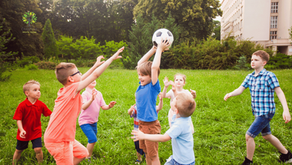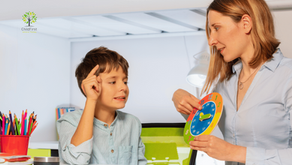7 Measures to Childproof Your House for Children with ASD
- ChildFirst Behavior Therapy

- Mar 12, 2024
- 6 min read

Childproofing your home is a crucial step in ensuring the safety and well-being of your child. When it comes to children with autism, additional considerations are necessary to create an environment that caters to their specific needs. Children with ASD may have unique requirements and preferences that will require special attention when childproofing a house. Let’s explore the seven measures to help you create a safe and comfortable living space for Children with ASD.
Autism-Friendly Spaces
In addition to creating autism-friendly spaces within your home, it's essential to tailor these areas to address specific needs. For tactile comfort, incorporate soft textures and comfortable seating options, such as bean bags or plush rugs. Provide items like fidget toys or textured fabrics to engage their sense of touch in a controlled and comforting manner.
For visuals, especially in the context of best ABA therapy in Arlington Heights, IL, opt for calming and neutral colors on the walls and furnishings. Avoid bright, contrasting colors that may be overwhelming. Consider using blackout curtains to control natural light and reduce visual stimuli, creating a more relaxed environment.
In addressing auditory needs, noise-canceling headphones or earplugs can be invaluable tools to help your child manage sound triggers. Introduce calming background music or white noise machines to drown out potentially distressing noises, creating a peaceful auditory atmosphere.
Secure Furniture and Heavy Items
Moreover, it's imperative to secure furniture and heavy items within the autism-friendly spaces to ensure a safe environment for your child. Children with autism may engage in repetitive behaviors or have tendencies that involve pushing, pulling, or climbing on furniture. Taking proactive measures to prevent accidents is essential for their well-being.
Anchor heavy furniture, such as bookshelves and dressers, to the wall using safety straps or brackets. This precautionary step ensures that these items remain stable and won't topple over if your child attempts to climb or pull on them. Regularly check and tighten these anchors to maintain their effectiveness over time.
Consider arranging furniture in a way that maximizes open space and minimizes potential obstacles. This not only reduces the risk of collisions and injuries but also provides a clear and uncluttered environment, which can be beneficial for children with autism.
Childproofing Doors and Windows
Childproofing doors and windows is a crucial aspect of creating a secure environment for Children with ASD, especially considering the potential for wandering. Installing childproof locks on doors and windows is an effective measure to prevent unsupervised access to potentially hazardous areas.
For doors, choose locks that are specifically designed to deter children from opening them independently. These locks often require a level of dexterity or understanding that young children might not possess. Additionally, consider installing locks at different heights to accommodate the various developmental stages of your child.
Secure Electrical Outlets and Cords
Safeguarding your home from potential electrical hazards is paramount, especially for children with autism who may exhibit heightened curiosity. Take the following steps to secure electrical outlets and cords:
Outlet Safety
Cover all electrical outlets with safety caps or plug covers to prevent accidental shocks. These childproofing devices are designed to fit securely into outlets, making them inaccessible to small fingers.
Consider using sliding outlet covers that automatically close when the plug is removed, providing an added layer of protection.
Cord Management
Use cord organizers or cable management systems to keep electrical cords neatly organized and out of reach. This not only minimizes the risk of entanglement but also prevents children from pulling on cords, reducing the likelihood of accidents.
Secure loose cords along walls or furniture to prevent tripping hazards and discourage unwanted exploration.

Safety in the Kitchen and Bathroom
Ensuring safety in the kitchen and bathroom is crucial for preventing accidents, especially for children with autism. Take the following precautions in these areas:
Kitchen Safety
Install safety latches on cabinets and drawers to keep potentially hazardous items, such as cleaning products and sharp objects, out of reach. Choose latches that are secure yet easy for adults to open.
Store commonly used items on lower shelves for easy access, reducing the need for your child to reach for potentially dangerous items.
Consider using childproof locks on the oven and stove controls to prevent accidental activation.
Bathroom Safety
Install safety latches on bathroom cabinets to secure toiletries, medications, and cleaning products. Keep these items out of reach to avoid accidental ingestion or contact.
Use non-slip mats or adhesive strips in the bathtub or shower to minimize the risk of slips and falls. Additionally, ensure that bath mats have a non-skid backing for stability.
Install faucet covers in the bathtub to protect against accidental burns from hot water. These covers act as a barrier between your child and hot surfaces, promoting a safer bathing environment.
Soft Edges and Cushioned Surfaces
Addressing the unique needs of children with autism, especially those prone to repetitive movements or behaviors, requires thoughtful measures to ensure their safety. Here are some key recommendations:
Sharp Edge Safety
Soft Padding: Cover sharp edges on furniture with soft padding or edge guards. This precautionary step minimizes the risk of injuries if your child engages in repetitive movements or accidental contact with these surfaces.
Cushioned Corners: Use specially designed cushioned corners on tables and other furniture to add an extra layer of protection, reducing the impact in case of contact.
Cushioned Play Areas
Soft and Cushioned Surfaces: Invest in soft, cushioned play areas to provide a safe and comfortable environment for your child to engage in activities. Consider foam mats or padded playmats to create designated spaces that minimize the risk of injuries during play.
Autism-Friendly Textures: Introduce textures that cater to your child's preferences, such as soft fabrics, tactile surfaces, or autism-friendly toys. This can enhance the overall experience while prioritizing safety.
Non-Slip Rugs
Rugs with Non-Slip Backing: Use rugs with non-slip backing to ensure stability and prevent accidental slips or falls. Securely place these rugs in play areas or commonly used spaces, creating a comfortable and secure foundation for your child's activities.
Establish Routine and Visual Cues
Recognizing the importance of routine and visual cues for Children with ASD, consider implementing the following strategies to create a supportive and structured environment:
Consistent Daily Routine
Establish a Predictable Schedule: Create a consistent daily routine for your child, incorporating activities such as meals, playtime, and bedtime at the same time each day. Predictability can provide a sense of security and stability.
Transition Warning: Offer gentle warnings before transitioning between activities to help your child prepare for the upcoming change. This can be done through verbal cues, timers, or other signals.
Visual Supports
Visual Schedules: Utilize visual schedules, charts, or calendars to represent the daily routine visually. Include pictures or symbols for each activity, allowing your child to understand and anticipate what comes next. This aids in promoting a sense of order and control.
Task Labels: Label storage bins, drawers, or specific areas with visual cues indicating the contents or purpose. This makes it easier for your child to locate and organize belongings independently.
Conclusion
Childproofing a house for an ASD child requires a thoughtful and customized approach to address their unique needs. By implementing these seven measures, you can create a safe and supportive environment that allows your child to explore, learn, and thrive in the comfort of their home. Regularly reassess and update childproofing measures as your child grows and their needs evolve, ensuring a safe and nurturing space for their ongoing development. If you need professional guidance and support in creating an optimal environment for your child or ABA Therapy Services in Arlington Heights, IL, consider reaching out to our experts at ChildFirst Behavior Therapy.
FAQs
Why is childproofing important for Children with ASD?
Childproofing is crucial for creating a safe and comfortable environment that caters to the specific needs of Children with ASD. It helps prevent accidents, addresses unique needs, and promotes a supportive living space.

How can I create autism-friendly spaces for my ASD child?
To create autism-friendly spaces, consider incorporating soft textures, comfortable seating options, calming colors, and tools like noise-canceling headphones. Tailor these spaces to address your child's tactile, visual, and auditory preferences.
What measures can I take to secure furniture and heavy items in my home?
Anchor heavy furniture to the wall using safety straps or brackets to prevent toppling. Arrange furniture to maximize open space and minimize obstacles. Regularly check and tighten anchors to maintain stability.
How do I childproof doors and windows to prevent wandering?
Install childproof locks on doors and windows, designed to deter independent opening. Place locks at different heights to accommodate your child's developmental stages and reduce the risk of unsupervised access.
What steps should I take to secure electrical outlets and cords?
Cover electrical outlets with safety caps or plug covers to prevent shocks. Use sliding outlet covers for added protection. Organize cords with management systems to minimize entanglement and secure them along walls or furniture to prevent tripping hazards.
How can I ensure safety in the kitchen and bathroom for my ASD child?
In the kitchen, install safety latches on cabinets, store items on lower shelves, and use childproof locks on oven and stove controls. In the bathroom, use safety latches on cabinets, non-slip mats in the bathtub, and faucet covers to protect against burns.
How do I address sharp edges and create cushioned play areas for my ASD child?
Cover sharp edges with soft padding or edge guards. Use cushioned corners on furniture. Invest in soft, cushioned play areas with autism-friendly textures to minimize the risk of injuries during play.







Comments